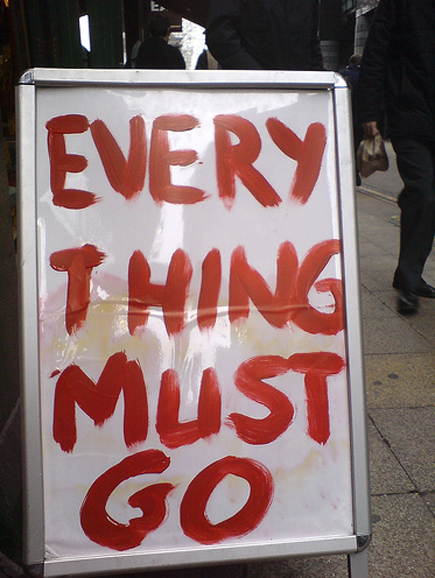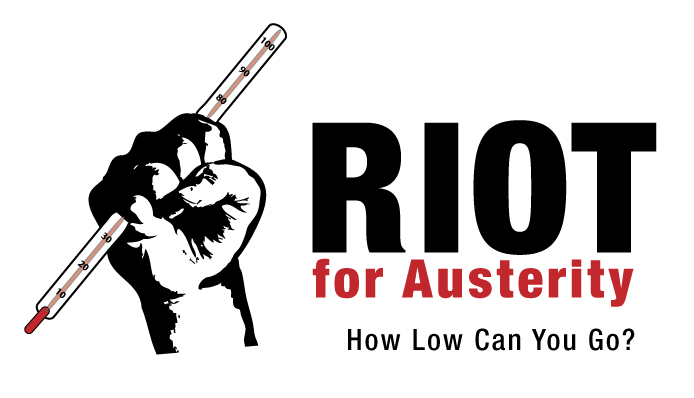As well as being a place to store our half-baked ideas, this blog is also meant to be a place where we can collect, record and circulate interesting stuff. And amidst all the shite that’s been written about the current credit/finance crisis, this piece (by George Caffentzis and Silvia Federici of Midnight Notes) really stands out. Read and think on…
“MUST THE MOLECULES FEAR AS THE ENGINE DIES?” –NOTES ON THE WALL STREET “MELTDOWN”
Dear Midnight Notes Friends,
The breakdown of the Wall Street financial machine makes the task that we outlined in our June meeting more urgent. In June we planned to rethink Midnight Notes in view of the restructuring of the accumulation process and class relations carried out through the neoliberal turn and Structural Adjustment. We can now define this project more precisely: what do the current crisis and restructuring of the financial system imply for us as we join the rest of the world in the dog house of structural adjustment in the twilight of the American empire?
In response to these questions, it is important, first, that we realize that the so-called Wall Street “meltdown” is certainly the end, but also the completion of the neoliberal program. Let us be clear about it. To think otherwise is to ignore the lesson taught to us by the event that opened the present capitalist era: the 1973 coup again the Chilean working class experiment with socialism, that led to the victory of strong state backed market economy. Karl Polanyi’s theory that the single most important cause of the rise of fascism and Nazism in Europe was the inability to control the financial market after the 1929 crash also resonates here. In other words, we should not read the restructuring taking place as a turn to socialism/Keynesianism, to the extent at least that Keynesianism was an intervention by the state into the economy aimed at increasing the state’s investment in social reproduction, starting with the reproduction of the working class, in exchange for an increase in the social productivity of labor. Despite the adoption of regulatory mechanisms, the operation presently conducted by the US government bears little resemblance to the Keynesian program launched with the New Deal.
Behind the $700 billion bail-out and the many others that will follow – some already in the pipeline – is a massive transfer of funds from the US working class to capital, inevitably leading to an assault on the last remaining entitlements (like Medicare, Social Security) and a general program of austerity the like of which we have not seen yet in a long time. The fact that there is no organized response to this assault makes us fear the worst. For things would never have reached this point if over the last decade the US workers had responded to the repeated thefts of their money and benefits, through the Enron scandal and the many other “crises” that have followed it. That despite the “instability” of the market, despite its usage as a means to expropriate thousands of small/working class investors, US workers continued to trust their livelihoods and future to it is certainly a key factor in what we are presently witnessing and Washington/Wall Street confidence in launching the new austerity program. It is our argument that in the same way as September 11 served the US government to shed the last remains of “democracy” and move to a model of government where militarization is always around the corner (apparently Representatives were threatened with the proclamation of martial law if they did not pass the bailout bill), so the Wall Street crash will serve to shed the last remaining elements of working class “socialism” in the US political economy, starting with Social Security, Medicare, a thorn in capital’s flesh, but so far demonstrating a great resilience, the last shore for working class struggle in the nation.
2. Lessons from the Debt Crisis
There is an important parallel here, not sufficiently noted, between the present crash and bail-out and the “debt crisis” of the 1980s, which engulfed most Third World nations (except for China) and was the start of the globalization process. Both have been engineered in the same fashion.
The “debt crisis” was the outcome of a financial campaign conducted by Washington and Wall Street, to practically force Third World nations to take cheap development loans – liberally dished out at the lowest interest rates – at a time when capital was refusing to invest in Europe and North America in the face of the most successful working class attack on its profit-rate since the 1920s, and a new generation of Africans, Asians etc. were organizing to demand a global redistribution of wealth and a program of reparations, that is, in the language of the Bucharest Conference of 1974: A NEW WORLD ORDER.
Through the lending mechanism, the massive flow of petrodollars that had been amassed in the aftermath of the 1974 embargo (the first attack on US wages, organized through a stiff inflationary wave) was redirected to the coffers of Third World nations, which, attracted by the bait of cheap loans, were soon hooked to the global economy, all dreams of an independent path to development foregone.
In other words, loans at the lowest interest rates were key to the creation of a global debt and the process of primitive accumulation (through structural adjustment) that was imposed on most of the workers of the world.
As we know, within less than a decade, the rise of the interest rates in the US, turned manageable debts into a long-term process of economic and political subordination. Debt became the hook for a massive restructuring of Africa’s, Asia’s & Latin America’s political economies, re-establishing a colonial dependency that for three decades has served to promote a massive transfer of funds from the Third to the First World and defeat the organizational efforts of TW nations for an independent road to development.
Under the guise of the “debt crisis,” portrayed as a case of “mismanagement” by backward countries, requiring First World-style financial responsibility, countries across the world were forced to open their books to Washington – via the IMF and World Bank – and accept any terms of repayment imposed on them. They were forced to freeze wages, terminate all social spending, open their markets to foreign investors and products, devalue their currencies and so forth. The consequences of these policies are well known. While Washington and NY built forests of skyscrapers, sucking on the blood of Africans, Asians, Latin Americans, Caribbean people, such levels of impoverishment and expropriation were imposed on the people of the world that millions took the road out of their countries, unable to survive in them, while those remaining witnessed epidemics, elimination of schools, famines, wars, the loss of ancestral lands, waters and forests, brutal wars of privatization, all directly related to the debt.
This is history now, though the politics of SAP have set back for decades the project initiated by the anti-colonial struggle, reformulated and reasserted, as I mentioned, at the Bucharest Conference of 1974, where TW nations emboldened by the defeat of the US in Vietnam, demanded a NEW WORLD ORDER, i.e. the redistribution, return of the wealth that Europe and the US have robbed from the colonial world.
With the debt crisis, international capital obtained three major objectives.
i) It disciplined the working class in Europe and the US, by dismantling its manufacturing structure and refusing for years to engage in any serious investment in these regions [remember “zero growth”?]
ii) It destroyed the attempt of the former colonial world to escape a dependent/subordinate position, as demanded by the new generation of Africans, Asians, etc., who, infused of the spirit of Fanon, were keen on import substitution schemes, were pressing for REPARATIONS, and pushing for some form of socialism (in Angola and Mozambique).
(iii). In addition to defeating revolution in First and Third World, the “debt crisis” built the infrastructure for the new global economy. It forged the mechanisms by which industries and offices could be relocated, companies could run around the globe, the work process could be computerized and streamlined and the working class thereby could be flexibilized and re-divided.
Against this background, we must note some basic similarities between the engineering of the debt crisis and the engineering of the Wall Street crash and must assume these similarities will extend to the social consequences of the crash. The housing bubble was the result of loans made at very low though adjustable credit rates, redirecting the influx of capital coming from abroad (China and other countries) toward the US market.
Is it possible that investment banks, credit rating agencies, the head of the Federal Reserve all FAILED to realize what would be the inevitable result of an “easy credit,” lending policy that reversed decades of regulatory principles and rules? Unless we want to revel in the nonsensical tale of a blinding surge in human greed, the answer must be a negative one. Thus, we must stop using the concept of “failure” to describe the absence of regulations and the reasons for the crash. We must rule out that the architects of the housing/mortgage crisis did not know it would end in a financial disaster and cascade of foreclosures for the home owners, in the same way as banks are partly responsible for the debt of the US working class ($45,000 on average per capita).
Continuing with the parallel, we have to conclude that with this 700 billion dollar “bail-out,” coming straight out of our pockets and hides, the “structural adjustment” that since the 1980s has been imposed on countries across the world, is going to be extended to the US territory and the US working class. This time (after many beginnings and many deferrals) we too are being “adjusted.” I will discuss later what adjustment will mean at this time for us. For the moment we only want to stress that we are witnessing not only a financial meltdown, but also a great robbery, a macro-process of expropriation, an immense transfer of labor, this time siphoning funds to the US banking system not only from the Third World, as in the Debt Crisis of the 1980s, but from our households, through the classic maneuver of increasing the national debt. What we are witnessing is a capitalist coup, an example of capital’s historic readiness to destroy itself in order to regain the initiative and defeat resistance to its discipline.
3. Where does this resistance come from? How is the collapse of the financial systems a response to it?
We cannot understand the Wall Street crisis unless we read it in class term as a means to negotiate a different class deal and response to class struggle and resistance. However, in dealing with these questions, I also want to distinguish this approach and the growing tendency to view every development in capitalist planning as a realization of working class struggle and demands, the Negrian perspective on capital’s response to class movements.
This perspective is dangerous, because besides turning even defeat into a victory, (such as: we wanted globalization, we wanted flexibilization, etc), it ignores the fact that a capitalist response must use working class demands against themselves, use them to drive part of the working class out of the struggle, turn it against or away from the other half, use them in such a way as to spark off forms of development that decompose the class.
Let us look now at the crisis as a disciplinary tools and strategy. There are at least three areas of resistance to the neoliberal accumulation project that the Wall Street collapse has to respond to. I will list them without an attempt to establish an order.
First, the crash and the bail-out must defeat the attempt of the US working class to circumvent class discipline by using financial markets, rather than struggle, sweat and labor, to increase their wages. While strikes and struggles have died out over the last two decades, workers have tried to increase their income in three ways: investing in the stock market, buying on credit, now even for everyday expenses, getting equity money through housing, and defaulting student loans. These tactics have clearly failed and now millions of workers are now to pay twice for them, in terms of their individual losses and in terms of the losses that will be inflicted on the US proletariat as a class through the bailouts. If successful, these bail-outs will in fact be conducive to a new regime of low wages and zero entitlements the like of which we have not seen since the last part of the 19th century.
The new regime will not be the end of market fundamentalism. It will be a revitalization of market investment through the injection of our social security money, and it will be a revitalization of some parts of American industry now presumably taking advantage of the fact that workers are desperate enough to accept any conditions just to have a job and a roof over their heads. A large part of capital has for a long time been lusting to bring back America to the situation before the New Deal, when employers had the upper hand. The “crisis” is giving them a chance to return to that era.
That this time Social Security is at stake is due to various factors. First, Social Security is the last pot of money available to re-launch the US market, in a context in which workers have no savings and monetary flows from the outside are drying out. It is also the last “scandal” on the list of US capitalists who have relentlessly for years now told us it must go. Most important of all, Social Security affects primarily the old, the retired, and it is therefore an easier target than entitlements affecting the whole working class.
So far workers in the US have resisted the privatization of Social Security despite many governmental attempts. But cuts in pensions have already gone a long way in the private sector, where employers have given stocks of their companies to workers, or stopped putting any money in their pension funds. The present crisis will extend that to government-backed pensions. And the road to it has been cleared by years of false statements to the effect that Social Security is unsustainable. Though it is a colossal lie, younger generations have, however, accepted it. By cutting Social Security, capital undoubtedly hopes to pit the young against the old, who (as in Africa today) are being pictured as a crew of selfish gerontocrats sucking up the funds the young need to build their future.
The second target of the attack is the global resistance to capital’s appropriation of natural resources beginning with oil and gas extraction. The defeat in Iraq is the peak of it. To this day, despite an immense expenditure in war funding, the US has not been able to put its hands on Iraqi oil. Resistance to international capital control over global energy resources has also come from Venezuela, Bolivia, and Ecuador. Many more countries are also refusing the neoliberal packet, especially in Latin America. These refusals, not peak oil, are the true limits to capital’s energy plans.
There have also been bottlenecks in the exploitation of forests, waters, minerals, and lands which structural adjustment was to remove. A new “rurban” peasant movement has been growing that is fighting independently of unions, parties, “civil society” and NGOs, using direct action tactics, to re-appropriate the lands and resources of which it has been robbed —poaching, harvesting timber or produce in commercial plantations, mining diamonds and gold “illegally,” or farming in the very lands from which they have been “legally” excluded. When they move to the cities they squat on urban land and take over land not used, private or public to farm it for their needs. It is a vast re-appropriation movement that is redefining the fundamentals of social reproduction globally. It has put globalizers and adjusters out of government, it has forced the nationalization of local resources, and has redistributed wealth and political power, putting the World Bank and IMF almost out of business in Latin America. It has defeated the attempt to completely liberalize the economies of the TW through the rule of the World Trade organization. Though not sitting at the table, the specter of the rural/urban peasants of the world has guided the refusal of TW representative to comply.
Third, global migration has developed in ways that make it difficult for governments to use it as a regulatory mechanism for the labor market. Far from being an easy device for driving wages down, migration is now an autonomous uncontrollable phenomenon, with a logic of its own that is not reducible to the needs of the labor market. It is important however to stress (against the idealization of the migrant and of Exit, Exodus, Flight as the highest form of struggle) that the struggle of the migrants is not superior to the struggle of those who remain. In fact, migration can lead to the dissolution of local organizations, it can create new divisions among the locals, separating those benefiting from remittances and those deprived of them, it can boost the cost of living in the area of origin by the influx of new money and hook local economies more strongly to the international monetary system, fostering the expansion of monetary relations. These, of course, are not inevitable results. Actually, migrants have been able to use the wage against the wage, to refuse impoverishment, to create transnational networks, to move from country to country seeking a better deal and nullifying national boundaries and borders.
The attacks on immigrants of recent months, which have seen the most massive factory raids and deportations ever in the US, are responses to this autonomy. They are part of the attempt to create a population of rightless workers, to function as a safety valve for the labor market. Only if they have no rights can immigrants function as regulatory mechanism for the labor market (in the same way as mass incarceration and expansion of unpaid labor do). The redefinition of immigrant workers as outlaws and the criminalization of the working class – historically a key strategy to devalue labor power – will continue to be a tool of the world order we will see emerging from the crisis. But the crash will intensify the divisions between “natives” and migrants, attack the organizational strength of migrant organizations, unless there is strong opposition to this strategy.
The Politics of the Financial Crisis and Our Response
Crises are always a threat and an opportunity as they break down business as usual, and reveal something of the inner workings and nastiness of capitalism. This one is not an exception and we can be sure that what will come out of it will be greatly a result of what people do in response to it. If the Great Depression is an indication, it took more than ten years for capital to organize a different social order. Much can happen in such a period.
The problem for us today is that workers are only organized around electoral politics at best. And many still place more hope in a racist and imperialist stance than in working class solidarity. We certainly don’t have a communist or an anarchist movement organizing rallies of the unemployed, fight against evictions, or organize “penny auctions” of farms as they did during the Great Depression. Nor do we have an anti-capitalist alternative as the Soviet Union was in the eyes of many. We also do not have the kind of solidarity that in the Great Depression led to invention of new commons, like the hobo movement and the creation of “jungle cities.”
Where to start then? This is what we need to work on in the coming months and years. There is no clear path to this kind of mobilization. But we need to start somewhere. On two things we can get people to agree with us: First, we better find alternatives, because, as things stand presently, we are so incestually connected with capitalism that its demise threats our own existence. Second, unless we organize to resist government planning, what lies ahead for us, after a cut of more than a trillion dollars of our “entitlements,” looks much more like some variant of fascism than socialism.
With warm greetings
Silvia and George









